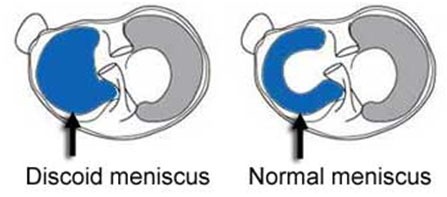Knee Joint
The knee is a hinge joint formed between the tibia (lower bone) and femur (upper bone), also called the Tibiofemoral joint, which is divided into the medial and lateral compartment. The patella glides over the front of femoral condyles to form a patellofemoral joint. In addition, there is the superior tibiofibular joint between the tibia and the head of the fibula (outer leg bone).
 The Knee joint is particularly susceptible to traumatic injury because it depends more on the ligaments due to less musculature around it for its strength and stability. The space between the tibia and femur is partially filled by two menisci (inner and outer sides) that are attached to add congruence. They aid in the lubrication and nutrition of the joint and act as shock absorbers.
The Knee joint is particularly susceptible to traumatic injury because it depends more on the ligaments due to less musculature around it for its strength and stability. The space between the tibia and femur is partially filled by two menisci (inner and outer sides) that are attached to add congruence. They aid in the lubrication and nutrition of the joint and act as shock absorbers.

The Functions of Different Ligaments of the Knee
| LIGAMENT | FUNCTION |
|---|---|
| Medial Collateral (inner side ligament) | Prevents medial (inner side) opening-up |
| Lateral Collateral (outer side ligament) | Prevents lateral (outer side) opening-up |
| Anterior Cruciate (within joint on the front side) | Prevents anterior (front) translation of the tibia on the femur |
| Posterior Cruciate (within joint on the backside) | Prevents posterior (back) translation of the tibia on the femur. |
NOTE: It must also be remembered that the lumbar spine (lower back), hip, and ankle may refer pain to the knee, and these joints must be assessed if it appears that joints other than the knee may be involved.
Clinical Significance
- Chondromalacia patella: Irritation of the cartilage on the underside of the kneecap (patella), causing knee pain. This is a common cause of knee pain in young people.
- Knee osteoarthritis: Osteoarthritis is the most common form of arthritis, and often affects the knees. Caused by aging and wear and tear of cartilage, osteoarthritis symptoms may include knee pain, stiffness, and swelling.
- Knee effusion: Fluid buildup inside the knee, usually from inflammation. Any form of arthritis or injury may cause a knee effusion.
- Meniscal tear: Damage to a meniscus, the cartilage that cushions the knee, often occurs with twisting the knee. Large tears may cause the knee to lock.
- ACL (Anterior Cruciate Ligament) strain or tear: The ACL is responsible for a large part of the knee’s stability. An ACL tear often leads to the knee “giving out,” and may require surgical repair.
- PCL (Posterior Cruciate Ligament) strain or tear: PCL tears can cause pain, swelling, and knee instability. These injuries are less common than ACL tears, and physiotherapy (rather than surgery) is usually the best option.
- MCL (Medial Collateral Ligament) strain or tear: This injury may cause pain and possible instability to the inner side of the knee.
- Patellar subluxation/ Dislocation: The kneecap slides abnormally or dislocates along the thigh bone during activity as a result patient complains of Knee pain and inability to walk.
- Patellar tendonitis: Inflammation of the tendon connecting the kneecap (patella) to the shin bone. This occurs mostly in athletes from repeated jumping.
Knee and Leg Pain Characteristics and the Possible Lesion
PAINS | LESION |
Sharp catching pain | Mechanical defect (trauma) |
Aching type pain with morning stiffness which eases with movements but gets worse with exertion | Degenerative changes |
Night pain | Degenerative changes, lateral cystic cartilage, Meniscal tear |
Pain on weight-bearing | Mechanical or arthritic lesion |
Pain while climbing up or down the steps or rising from a chair | Patellofemoral origin |
Pain on twisting | Meniscal origin |
Pain over bony eminence below the knee in young adults | Osgood Schlatter’s disease |
Common Causes of Knee and Leg Pain:
1) Knee Ligament Injuries
2) Meniscus injury
3) kneecap (patellar) Pain
- Chondromalacia Patella
- Fat Pad Syndrome
- Patella Dislocation
- Patellofemoral Pain Syndrome
- Osgood Schlatter’s disease
- Sinding Larsen Johansson Syndrome
4) Knee Arthritis
5) Knee Tendonitis
- Patellar Tendonitis (Tendinopathy)
- Pes anserinus Tendinitis
- Popliteal Tendonitis
6) Muscle Injuries
- Thigh Strain
- Hamstring Strain
- IT Band Friction Syndrome
- Popliteus syndrome
- Muscle Cramps
- DOMS – Delayed Onset of Muscle Soreness
- Quadriceps contusion injury
7) Knee Bursitis
8) Other Knee-Related Conditions
Suffering from Knee and Leg Pain? Visit Pain Free Physiotherapy Clinic at Dwarka, Delhi, or Call us to book an Appointment for Home Visit.





